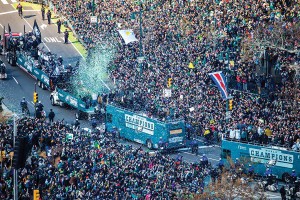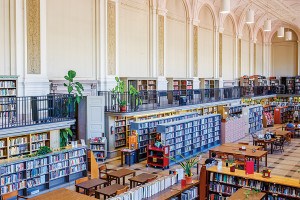The Smartest People in Philadelphia
The Smartest People in Philadelphia
City
Jeremy Nowak
The Godfather of Grants
As the new head of the William Penn Foundation, Nowak, 60, has been putting serious financial heft behind the most innovative, experimental and exciting stuff happening in schools, the environment, media and the arts. “Organizations I’ve thrown my energy into—the Reinvestment Fund, Mastery Charter Schools, now the William Penn Foundation—are those that focus on civic change and ask big questions,” he says. “What’s the best way to rebuild a distressed city? How can you turn around the worst-performing schools? How can we redesign institutions for a new time?”
Glen Abrams & Howard Neukrug
The Water Guardians
New parks. Rain gardens. Green roofs. Porous concrete. The Water Department’s Green City, Clean Waters plan, led largely by PWD’s Abrams and Neukrug, is massive: a 25-year blueprint and testing ground for making the city (any city!), as Abrams puts it, a prettier, “spongier” place. More sponges—that is, sustainable green surfaces—manage rainwater, keeping the filthy urban runoff from dirtying our rivers and overflowing our sewers. Here’s a street view of some of what G.C.C.W. looks like.
Susan Weiler
The Landscape Visionary
When Weiler, 57, looks at Philly’s skyline, she doesn’t see the buildings, but rather the spaces between them—the “connective tissue of open space.” And as a partner at renowned Olin landscape architecture firm, she’s been a major player in the transformation of the connective tissue along the Ben Franklin Parkway. Her goal? To turn the Parkway into “the biggest urban arboretum in the country.” Here, a look at what she’s done there, what she’s doing, and what she dreams about.
1. Logan Circle: One of Weiler’s first Parkway projects renovated the landmark for the 100th anniversary of the Lewis and Clark Expedition in 2005. She used plants the duo brought back to Philly from their travels. Completed
2. Rodin Museum: The museum’s $9.1 million restoration, completed in July, was described by PMA director Timothy Rub as “a timeless melding of setting and collection.” Completed
3. Barnes Foundation: It was Weiler’s colleague and the firm’s namesake, Laurie Olin, who took the lead on the Barnes. “It’s a series of gestures that address both the museum landscape and the public landscape of the Parkway,” Weiler says. Completed
4. PMA Sculpture Garden: “It was a kick to do a garden on top of 442 parking spaces.” Completed
5. Sol LeWitt Garden: Weiler finally brought the artist’s conceptual landscape art, commissioned 30-plus years ago, to fruition in May. Completed
6. Italian Fountain: The revitalization of the fountain is part of a larger Olin project to create a new park behind the PMA. In the works
7. Dilworth Plaza: “There wasn’t a real front door or honorific plaza in front of City Hall,” says Weiler. “We knew right away that you had to get rid of the hole, bring it to street level and get rid of all those barriers, making it accessible and energetic.” In the works
8. Eakins Oval: A major flaw of the Parkway’s current design, Weiler says, are the traffic lanes separating the PMA from Eakins Oval. Eliminating them would be a step toward making the Parkway more pedestrian-friendly. Would love to do
9. LOVE Park: “Those stairs don’t need to be there. It needs to be brought back down to the pedestrian level of the city.” Would love to do
Paul Levy
The Urban Planner
Levy has been here forever as president of the Center City District, but is somehow still the guy behind everything new and cool. (See: Dilworth Plaza; Sister Cities Park.) “Successful places are dynamic multi-use places,” he says. “We’ve planned for that.”
Meryl Levitz
The Philly Promoter
Quick—name the first ad campaign to come from Philly that springs to mind. It’s the one for Philly, right? For “With Love, Philadelphia”—and for tapping into that untapped LGBT travel market 10 years ago, and for drawing 38 million visitors (and their cash) here last year—Levitz and team remain some of the brightest branding brains around.
John Fry
The Connector
As Penn’s executive VP, Fry spent the ’90s growing that campus and surrounding neighborhood. Now he’s back in University City as Drexel’s president, with another vision—a five-year, $500 million development plan that will drastically change the place forever. From high-rise dorms to block-fuls of new businesses, Fry, 52, wants a “high-impact university-community partnership that will lift Drexel and its surrounding neighborhoods to new heights.” We asked for his color commentary on some plan highlights.
1. The Papadakis Integrated Sciences Building, 2011, “This building arrived just in time, coincidentally, with our affiliation with the Academy of Natural Sciences. It brought life science and environmental science to the fore at Drexel.” Completed
2. The URBN Center of the Antoinette Westphal College of Media Arts & Design, September 2012, “I don’t know that there’s a space in Philadelphia that encourages creativity better.” Completed
3. The LeBow College of Business building, “It will be our largest academic building, and really connect to the corporate world just up Market Street in Center City. That it was made possible by the largest gift in our history, $45 million from alumnus Ben LeBow, is a testament to the quality and impact of a Drexel business education.” In progress
4. Chestnut Square, 19-story dorm towers anchored by retail and restaurants, “Our private partnership to build Chestnut Square represents a new model we’ll be using to develop student housing and retail, to increase the vitality of our campus and surrounding neighborhoods.” In progress
5. JFK Boulevard redevelopment, 30th to 32nd streets, “This ‘superblock’ is Philadelphia’s greatest untapped real estate opportunity. Drexel’s developed a compelling vision for an ‘Innovation Neighborhood’ of academic, residential, retail and commercial uses, anchored by 30th Street Station and serving as University City’s gateway.” On the horizon
6. 34th Street and Lancaster Avenue mixed-use development: student residences, entertainment amenities and retail space, “Lancaster Avenue has the potential to be University City’s ‘Main Street,’ drawing not only students and neighbors, but people from across the city and region.” On the horizon
Alex Gilliam
The Child-Labor Advocate
Through his Tiny Works Project Administration, architect Gilliam aims to improve Philly via “tiny” projects conquered by local kids, like the pop-up playground in Rittenhouse spearheaded with PHS last month. “My mathematical equation for Tiny WPA is: Teens plus power tools plus the initiative for improvement in their communities equals great civic engagement and innovation.”
Scott Gordon
The School Savior
Gordon—a product of Cherry Hill East and Yale business school—opened his first Mastery Charter School 11 years ago. Eleven successful charters—many of them turnarounds of the most violent, lowest-performing spots in the Philadelphia school district—and nearly 8,000 students later, Mastery has become a national model for public-school reform.* “I believe it could happen at every single Philadelphia school,” he says. Here, more of Gordon’s vision:
- “A great school is about great teachers. We’ve invested a tremendous amount of energy and time and resources into what we think is a national model for supporting great teachers.”
- “Running a school is like running any other high-performing organization. You need clear goals. We have performance-based pay, so high-fliers get paid more, and folks who don’t, get the feedback that can lead to improvement. That’s very unusual in the world of schools.”
- “We’re looking for our kids to graduate from college at twice the national rate, which is about six times the Philadelphia rate.”
- “Poverty is not an excuse. It may be an obstacle to overcome, but poverty is not destiny.”
- “We sweat the small stuff. Often, low-performing schools have unruly environments because students don’t believe the school will follow through with its rules. Sweating the small stuff means that a school does what it says 100 percent of the time.”
- “We’re beginning a pilot of what’s called ‘blended learning’: We have our math students in one of our schools getting the initial lesson from the computer in a self-directed fashion, then working in small groups with teachers and applying the learning to projects, to make sure they really learned it and can apply the information. It’s pulling apart the classroom and hopefully putting it back together in a way that’s much more effective.”
*The Gates Foundation is currently working to install the Mastery Teacher Effectiveness Program in school districts across the country.
Brian Phillips
The New Architect
Phillips, 41, built a prototype for a green rowhome in East Kensington that only cost $100,000. He created “quick and cheap”—albeit handsome—dorms at Temple out of prefab boxes. Now he’s working on a nearly-zero-energy construction project in Camden. “Professions evolve in times of crisis,” he says. “Architects need to think differently.”
>> Click here to see the Smartest People in Philadelphia: Food & Booze


